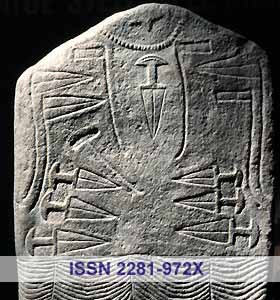TRACCE no. 8 – by J.M.V. García, I. Montero Ruiz, A. R. Alcalde
Digital image processing and prehistoric art.
the digitalizing of the Rock Art Archives of the Departamento de Prehistoria (Centro de Estudios Históricos, C.S.I.C.). Read more
TRACCE no. 8 – by J.M.V. García, I. Montero Ruiz, A. R. Alcalde
Digital image processing and prehistoric art.
the digitalizing of the Rock Art Archives of the Departamento de Prehistoria (Centro de Estudios Históricos, C.S.I.C.). Read more
TRACCE no. 7 – by J.M. Bello
La organización del III Coloquio, que se desarrollará en La Coruña (Galicia, España) entre el 8 y el 13 de septiembre de 1997, corre a cargo de J.M. Bello, R. de Balbín y P. Bueno, con la colaboración de B. Bas, M. Rey y M. San Claudio, bajo el patrocinio del Ayuntamiento de La Coruña a través del Museo Arqueológico e Histórico de dicha ciudad. Read more
TRACCE no. 6 – by Jane Kolber
Scale drawings of the Vale de Vermelhosa Engravings.
The Etched in Time Project invited me to be a participant in recording the engravings in the Vale de Vermelhosa (Côa Valley Area, Portugal). Read more
TRACCE no. 5 – by Côwa Valley Rock Art
A joke about some “fresh” figures of palaeolithic Côwa Valley rock art… Read more
TRACCE no. 5 – by Belinha Campos
Observations on the use of two different rock art tracing methods at Vale de Vermelhosa (Côa area), during the project “Gravado no tempo – Portugal” (Etched in time – Portugal), lead by Mila Simões de Abreu and Ludwig Jaffe. Read more
TRACCE no. 5 – by José António Bravo Nunez
The geology of the Douro and Côa Valley: general aspects of the rock art areas.
RRegarding the morphostructural units in the Iberian Peninsula, the region of Vila Nova de Foz Côa is part of the Iberian Massif, a fragment of the hercynian block that includes 75% of the peninsular soils, with an altitude of about 600 m above sea level.. Read more
TRACCE no. 5 – by Andrea Arcà
Palaeolithic figures in rock n. 1 of the Vermelhosa – Côa Valley area.
Rock n. 1 of the Vermelhosa Valley (Côa Valley area) lies at 180 m altitude, on the left orographic side of the Douro River, which is flowing few scores of meters below.. Read more
TRACCE no. 5 – by Angelo Fossati
The Iron Age in the Rock Art of Vermelhosa, Portugal.
Besides the figures attributable to the Palaeolithic times there are also petroglyphs that can be dated to the Iron Age (1st Millennium BC). These figures are engraved scratching the rock surface, sometimes with a stone, other times with a metal tool, as it is possible to note from the outlining. Read more
TRACCE no. 5 – by M.S. Abreu, A. Arcà, A. Fossati, L. Jaffe
The Vermelhosa site and the “Etched in time” project.
The Vermelhosa site is situated in a small lateral little valley on the orographic left side of the Douro river, less than 1 km down from the Côa confluence in the Douro. Read more
TRACCE no. 5 – by M.S. Abreu, A. Arcà, A. Fossati, L. Jaffe
The Movement to save Côa Valley engraved rocks was started and led by Mila Simões De Abreu and Ludwig Jaffe, and internationally sustained by many Archaeological scholars, Institutions and Universities (Universidad de Alcalà de Henares, Institut of Archaeology London, Université de Poitiers, British Academy, Society for American Archaeology, University of Bristol, Australian Academy of the Humanities, University of New Mexico…). Read more
TRACCE no. 5 – by M.S. Abreu, A. Arcà, A. Fossati, L. Jaffe
The great importance of Côa Valley Rock Art reached the headlines of the Portuguese and international press in November 1994. Even now it is taking a big place in Portuguese research, where a distinct division has been defined between the so called A.C. (Antes do Côa – before the Côa) and D.C. (Depois do Côa – After the Côa) Archaeology. Read more
TRACCE no. 5 – by Luiz Oosterbeek
De Foz Côa à l’ensemble du territoire Portugais: pur un nouveau rapport du Patrimoine avec la Société
Les musées sont aperçus, souvent, come des lieux de mémoire. Cette vision, certainement valable, est pourtant restreinte. Read more
TRACCE no. 4 – by Andrea Arcà – Angelo Fossati
A question of skin: AMS vs. Rupestrian Archaeology?
The second aspect of direct dating experiences in Côa Valley is AMS method. We will refer here to the text recently issued in Rock Art Research volume 12 number 2. Read more
TRACCE no. 4 – by João Zilhão
At the request of the editor of TRACCE, I comment here on the text by Robert Bednarik published in number 3, May 1996, of this online rock art newsletter. I do it as a token of consideration toward the editor and the cooperative Le Orme dell’Uomo, an organization that played an important role in rallying international support to preserve the Côa Valley rock art sites. Read more
TRACCE no. 3 – by Antonio Alvarez Nuñez
During the Prehistoric Stage the cultural heritage of Galicia was enriched with artistic demonstrations that are extremely striking, due to their strength of personality, art that is exposed to the open air: petroglyphs. Read more
TRACCE no. 1 – by Andrea Arcà
Direct dating: does it work? The Côa Valley experience. For the first time in Europe supposed scientific direct dating methods on open air rocks have been applied. According to the necessity of doing an experimental test, the site chosen was little and not relevant: the Côa Valley petroglyph site, the first European open air rock art site in palaeolithic style.
Read more
